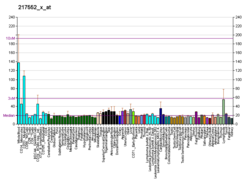
Back Knops sistem antigena BS CR1 Welsh Komplementrezeptor 1 German Рецептор комплементу 1 Ukrainian
This article needs additional citations for verification. (August 2008) |
Complement receptor type 1 (CR1) also known as C3b/C4b receptor or CD35 (cluster of differentiation 35) is a protein that in humans is encoded by the CR1 gene.[3][4]
This gene is a member of the regulators of complement activation (RCA) family and is located in the 'cluster RCA' region of chromosome 1. The gene encodes a monomeric single-pass type I membrane glycoprotein found on erythrocytes, leukocytes, glomerular podocytes, hyalocytes, and splenic follicular dendritic cells. The Knops blood group system is a system of antigens located on this protein. The protein mediates cellular binding to particles and immune complexes that have activated complement. Decreases in expression of this protein and/or mutations in its gene have been associated with gallbladder carcinomas, mesangiocapillary glomerulonephritis, systemic lupus erythematosus and sarcoidosis. Mutations in this gene have also been associated with a reduction in Plasmodium falciparum rosetting, conferring protection against severe malaria. Alternate allele-specific splice variants, encoding different isoforms, have been characterized. Additional allele specific isoforms, including a secreted form, have been described but have not been fully characterized.[3]
In primates, CR1 serves as the main system for processing and clearance of complement opsonized immune complexes. It has been shown that CR1 can act as a negative regulator of the complement cascade, mediate immune adherence and phagocytosis and inhibit both the classic and alternative pathways. The number of CR1 molecules decreases with aging of erythrocytes in normal individuals and is also decreased in pathological conditions such as systemic lupus erythematosus (SLE), HIV infection, some haemolytic anaemias and other conditions featuring immune complexes.[5] In mice, CR1 is an alternatively spliced variant of the complement receptor 2 (CR2) gene.
Certain alleles of this gene have been statistically associated with an increased risk of developing late-onset Alzheimer's disease.[6][7]
- ^ a b c GRCh38: Ensembl release 89: ENSG00000203710 – Ensembl, May 2017
- ^ "Human PubMed Reference:". National Center for Biotechnology Information, U.S. National Library of Medicine.
- ^ a b "Entrez Gene: CR1 complement component (3b/4b) receptor 1 (Knops blood group)".
- ^ Moulds JM, Nickells MW, Moulds JJ, Brown MC, Atkinson JP (May 1991). "The C3b/C4b receptor is recognized by the Knops, McCoy, Swain-langley, and York blood group antisera". The Journal of Experimental Medicine. 173 (5): 1159–63. doi:10.1084/jem.173.5.1159. PMC 2118866. PMID 1708809.
- ^ Khera R, Das N (February 2009). "Complement Receptor 1: disease associations and therapeutic implications". Molecular Immunology. 46 (5): 761–72. doi:10.1016/j.molimm.2008.09.026. PMC 7125513. PMID 19004497.
- ^ Lambert JC, Heath S, Even G, Campion D, Sleegers K, Hiltunen M, et al. (October 2009). "Genome-wide association study identifies variants at CLU and CR1 associated with Alzheimer's disease". Nature Genetics. 41 (10): 1094–9. doi:10.1038/ng.439. hdl:10281/9031. PMID 19734903. S2CID 24530130.
- Alice Park (2009-09-07). "Breakthrough Discoveries of Alzheimer's Genes". Time. Archived from the original on 2009-09-09.
- ^ Fonseca MI, Chu S, Pierce AL, Brubaker WD, Hauhart RE, Mastroeni D, et al. (2016). "Analysis of the Putative Role of CR1 in Alzheimer's Disease: Genetic Association, Expression and Function". PLOS ONE. 11 (2): e0149792. Bibcode:2016PLoSO..1149792F. doi:10.1371/journal.pone.0149792. PMC 4767815. PMID 26914463.
© MMXXIII Rich X Search. We shall prevail. All rights reserved. Rich X Search





